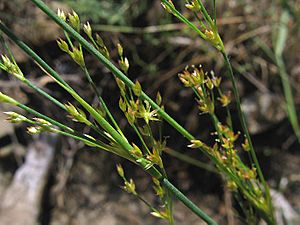Wrinkled rush facts for kids
Quick facts for kids Wrinkled rush |
|
|---|---|
 |
|
| Scientific classification | |
| Genus: |
Juncus
|
| Species: |
dubius
|
| Synonyms | |
|
|
The Juncus dubius is a type of plant called a rush. People often call it the wrinkled rush because of its stem. This plant only grows naturally in California. You can find it in places like the California Coast Ranges, Transverse Ranges, and the southern Sierra Nevada. It loves wet spots, so it often grows near marshes and riverbanks.
Contents
What is the Wrinkled Rush?
The wrinkled rush is a plant that lives for many years. It grows in thick clumps, almost like a small bush. These clumps grow from a special underground stem called a rhizome. A rhizome helps the plant spread out.
How Does the Wrinkled Rush Grow?
The main stem of the wrinkled rush stands straight up. It is green and can grow up to about 70 centimeters tall. That's almost as tall as a typical 12-year-old! A cool thing about its stem is that it looks wrinkled or rippled. This is how it got its common name.
The plant does not have many leaves. The leaves at the bottom of the plant are like tubes that wrap around the stem. They do not have flat parts like most leaves. The leaves higher up on the stem are shaped like thin cylinders.
What Do Its Flowers Look Like?
The flowers of the wrinkled rush grow in an open, spread-out group. This group of flowers is called an inflorescence. Many small clusters of flowers grow on these spreading branches. Each cluster has only a few tiny flowers.
The flowers have small, clear leaf-like parts called bracts. Each flower has reddish or brownish-green parts called tepals. These tepals are like petals and sepals combined. They have thin, see-through edges and tiny bristles at their tips. Inside each flower, there are six stamens. Stamens are the parts that make pollen.
What About Its Fruit?
After the flowers bloom, the plant makes a fruit. This fruit is a red or brown capsule. A capsule is like a small seed pod. The fruit of the wrinkled rush is bigger than the flower it grows from.

